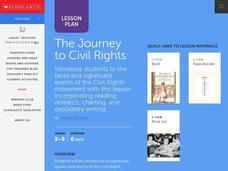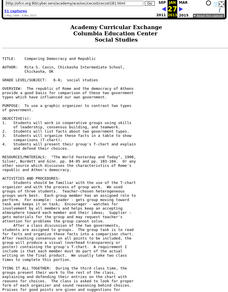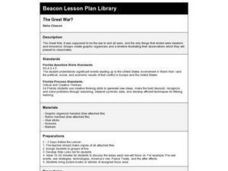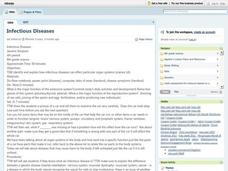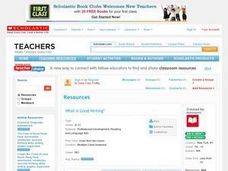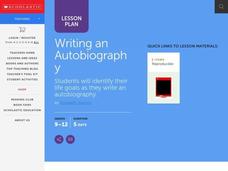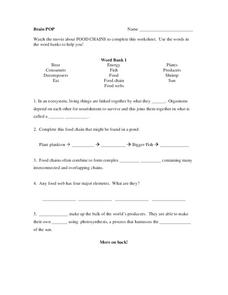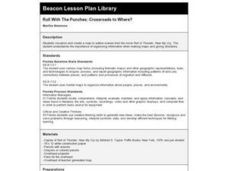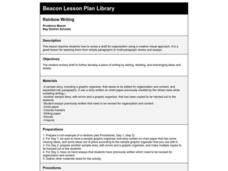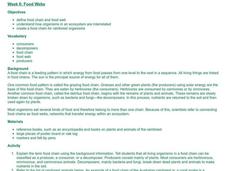Curated OER
The Journey to Civil Rights
Young scholars investigate the concepts that surround the Civil Rights Movement. They conduct research with the help of the teacher and use chart paper to create posters about major people involved. Students also complete a timeline...
Curated OER
Stitching Truth Lesson One: What is Civil Society?
Ninth graders create a working definition of civil society. In this US History lesson, 9th graders create a list of terms that help make up the term civil society. Students examine the case study of life in Pinochet's Chile.
Curated OER
Pond Life Identification Kit
Young scholars explore ecology and biodiversty. They use the wet-mount procedure to make several slides to view using the microscope and draw what they see.
Curated OER
Comparing Democracy and Republic
Learners use a graphic organizer, a T-chart, to contrast two types of government. They list facts about the two governments, and explain and defend their choice of facts to include.
Curated OER
Designer Genes For A Designer World
Students explore how organisms adapt to their environments through changes in their genetic codes. They create make-believe creatures and environments that have specific characteristics.
Curated OER
The Great War?
Students explore The Great War and create graphic organizers and a timeline illustrating their observations.
Curated OER
Flowers: Form and Function
Students recognize and name the parts of a flower. They explain the function of each part of a flower. Students list the steps that occur for sexual reproduction of a plant to take place. They recognize and name the male reproductive...
Curated OER
Infectious Diseases
Eighth graders identify and explain how infectious diseases effect organ systems. Using an analogy with automobiles and body systems, they discover how one part influences the operation of the whole. Students write paragraphs about...
Curated OER
Natural Selection I
Eighth graders list the steps of Darwin's natural selection. They demonstrate the process of natural selection in a predation activity. Students create paper origami frogs to race across the floor and analyze the differences in the...
Curated OER
What Can We Do to Help Others?
Young scholars explore the concept of philanthropy. In this service learning lesson, students select local nonprofit organizations that may benefit from their service. Young scholars welcome a spokesperson from a local organization...
Curated OER
What Are Ecosystems?
Third graders recognize and examine ecosystems. They observe and describe habitats within ecosystems and observe and identify organisms with similar needs that compete for resources.
Curated OER
Classification 2
Students discuss what makes a living thing (for example, cellular respiration) and collect a selection of living things from outside. They divide their organisms into plants and animals and create a key for the divisions.
Curated OER
Aquatic Ecosystems
Ninth graders record information on aquatic ecosystems and create a labeled diagram of an ecosystem of their choice. They can choose from an ocean zone, estuary, river, lakes, or beaches. The student has to explain their biome of choice.
Curated OER
What is Good Writing?
Pupils assess samples of writing for each trait and discuss rationale for scoring. They comprehend that the traits of writing offer a common language for revision. Students are shown how to asses their writing and what makes good writing.
Curated OER
Writing an Autobiography
Students identify life goals as they write an autobiography. They write a strong introduction for their autobiography. Students write a sequences of events using their Life Map as a graphic organizer. They write facts accurately...
Curated OER
A Character's Decalogue Using "Because of Winn Dixie"
Pupils read the book Because of Winn Dixie and then create a personal decalogue, which is a list of 10 personal beliefs. In this decalogue lesson plan, students then write a decalogue of a fictional character and write a story based on it.
Curated OER
Food Chains
In this chemistry worksheet, students watch a movie about food chains and use it to respond to each of the questions stated. They use the list of works in the word banks to assist them in matching the correct term to its description.
Curated OER
Critters in Your Own Backyard
Young scholars identify various animals and their habitats, as well as their specific traits In this animal habitat lesson, students list animals they've seen in their backyard. Young scholars select one animal and do research. Students...
Curated OER
Roll With The Punches: Crossroads to Where?
Third graders visualize and create a map to outline scenes from the novel Roll of Thunder, Hear My Cry. They understands the importance of organizing information when making maps and giving directions.
Curated OER
Rainbow Writing
Students examine how to use a rainbow picture as a graphic organizer through the use of color-coding. They produce a writing piece using this graphic organizer. They expand their writing from simple paragraphs to multi-paragraph stories.
Curated OER
Food Webs
Students research rainforest animals and use that information to make a flow chart to show the order in which energy is transferred through several organisms. They label the producers, consumers, and decomposers in their chart.
Curated OER
Economic Concepts and Definitions
Third graders identify producers and consumers in SE Utah and Four-Corners communities. They identify the factors that determine economic development and name some occupations in their community. They show and share their graphic...
Curated OER
Classifying Life
In this classifying life worksheet, students review the 5 kingdoms of organisms by completing 10 matching and 7 fill in the blank questions.
Curated OER
Eastern Woodland Indians
Fifth graders research the Eastern Woodland Indians in this lesson. They list the tribes and write a description of the physical environment. They list examples of the types of food, clothing, transportation, home/shelter,...
